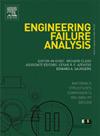焊点热循环退化的三维x射线显微镜和力学分析
IF 5.7
2区 工程技术
Q1 ENGINEERING, MECHANICAL
引用次数: 0
摘要
根据IPC-9701B标准,研究了安装在印刷电路板上的innolot焊接芯片电阻在- 40°C至125°C之间加速热循环的热疲劳行为。使用高分辨率3D x射线显微镜分析焊点的退化,间隔500到2500次循环,辅以机械剪切测试和扫描电子显微镜(SEM)。关键评价指标包括裂纹长度、焊料与总体积比、空隙直径和空隙密实度。结果表明,在某些情况下,整个节理的裂纹长度随着热循环而增加,尽管不同平面上的裂纹扩展模式不同,这强调了三维分析的重要性。焊料与总体积比在初始培养阶段呈线性下降,作为接头降解的可靠指标。由于热循环,孔隙变大,变形增多,致密度降低。与其他样品(27.7 N和28.6 N)相比,退化最严重的组分(11.3 N)的峰值剪切力显著降低。这可以用最高的平均裂纹长度、空洞增长或体积损失来解释,但SEM图像显示了另一个重要因素,即失效主要发生在大块焊料中,另外两种情况发生在金属间层中。本文章由计算机程序翻译,如有差异,请以英文原文为准。
3D X-ray microscopy and mechanical analysis of thermal cycling-induced degradation in solder joints
This study investigates the thermal fatigue behavior of Innolot-soldered chip resistors mounted on printed circuit boards, subjected to accelerated thermal cycling between −40 °C and 125 °C in accordance with the IPC-9701B standard. The degradation of solder joints was analyzed using high-resolution 3D X-ray microscopy at intervals of 500 cycles up to 2500 cycles, complemented by mechanical shear testing and scanning electron microscopy (SEM). Key evaluation metrics included crack length, solder-to-total volume ratio, void diameter, and void compactness. Results showed that crack lengths increased with thermal cycles in some cases across the whole joint, although growth patterns varied across different planes, underscoring the importance of three-dimensional analysis. The solder-to-total volume ratio demonstrated a linear decrease with an initial incubation phase, serving as a robust indicator of joint degradation. Voids became larger and more deformed, with compactness decreasing due to thermal cycling. The peak shear force was significantly reduced in the most degraded component (11.3 N) compared to the other samples (27.7 N and 28.6 N). This can be explained by the highest average crack length, the void growth or with volume loss, however the SEM images revealed another significant factor, which is failure happened in the bulk solder mainly while in the other two cases in the intermetallic layer.
求助全文
通过发布文献求助,成功后即可免费获取论文全文。
去求助
来源期刊

Engineering Failure Analysis
工程技术-材料科学:表征与测试
CiteScore
7.70
自引率
20.00%
发文量
956
审稿时长
47 days
期刊介绍:
Engineering Failure Analysis publishes research papers describing the analysis of engineering failures and related studies.
Papers relating to the structure, properties and behaviour of engineering materials are encouraged, particularly those which also involve the detailed application of materials parameters to problems in engineering structures, components and design. In addition to the area of materials engineering, the interacting fields of mechanical, manufacturing, aeronautical, civil, chemical, corrosion and design engineering are considered relevant. Activity should be directed at analysing engineering failures and carrying out research to help reduce the incidences of failures and to extend the operating horizons of engineering materials.
Emphasis is placed on the mechanical properties of materials and their behaviour when influenced by structure, process and environment. Metallic, polymeric, ceramic and natural materials are all included and the application of these materials to real engineering situations should be emphasised. The use of a case-study based approach is also encouraged.
Engineering Failure Analysis provides essential reference material and critical feedback into the design process thereby contributing to the prevention of engineering failures in the future. All submissions will be subject to peer review from leading experts in the field.
 求助内容:
求助内容: 应助结果提醒方式:
应助结果提醒方式:


